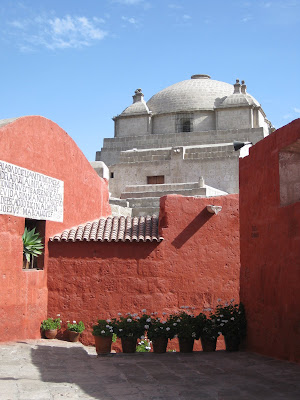I have now declared all Saturdays to be official "Be a Tourist Day." I go down the list in my Frommer's, each weekend visiting a choice destination in Arequipa.
For the first "Be a Tourist Day", Sergio and I went to the Santa Catalina Monastery, founded in 1579, only forty years after the Spanish arrived to Peru.

We paid 30 soles ($10) to enter, a chunk of dough considering that a good dinner could cost only three soles ($1). But when you are a tourist, you pay tourist prices.
The monastery, situated near the main plaza, is said to be the finest example of colonial architecture in Arequipa, and the finest religious monument in the country.
It was built with sillar, a form of white volcanic rock that is said to give Arequipa it's name: la ciudad blanca (the white city). The design now tells the story of various earthquakes over the years, at least two biggies in 1958 and 1960 that changed the monastery drastically.
From this picture, you can see just one of the many small Spanish-style streets within the monastery. A city within a city, the monastery is filled with winding cobblestone streets, gardens and courtyards.
It's always good to have an inside source, and we found ours; the man running the gift shop inside the monastery gave us the real scoop. While the brochure says that the monastery was open to women of all financial and ethnic backgrounds, our source had another story to tell:
Only Spanish women could be nuns at Santa Catalina. With them, they had to bring more than enough to pay for their food and board for the year--usually paid for with property. Along with them, they had to bring at least one servant, usually indigenous or black.
In fact, Arequipa got the name "white city" not because of the volcanic rock--because originally all of Arequipa's white sillar was painted in the rust and blue, as the monastery appears today--but because of the people.
He said that the Incas and pre-Incan cultures were not stupid enough to build an important city at the base of a volcano, like the Spanish did in founding Arequipa at the base of Misti. Arequipa was a colonial center, a fact evident in the color of the population, said our insider.
The monastery is still in use, and has very different requirements. There are nearly 35 nuns who still live there, aging from 18 to 83. Instead of a hefty dowry, the nuns can join Santa Catalina without paying a dime. Neither their financial or ethnic background matters, only their level of commitment to their faith.

Sadly, my Frommer's tells me that the site appeared on the list of the "2008 World Monuments Watch list of Most Endangered Monuments." Beyond the threat of devastating earthquakes, the effects of pollution can be seen on the monastery walls. Smoke and graffiti have stained the antique sillar walls.



.jpg)
No comments:
Post a Comment